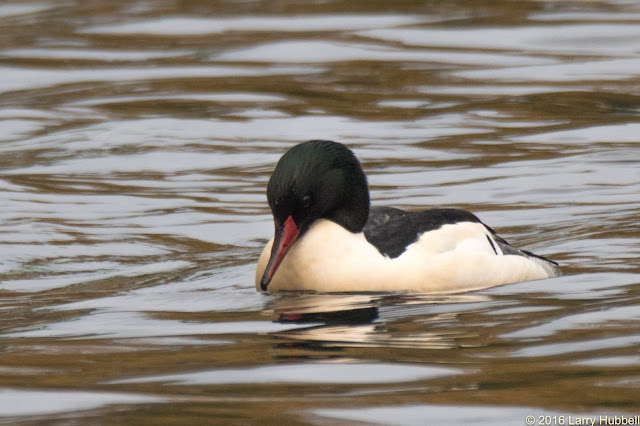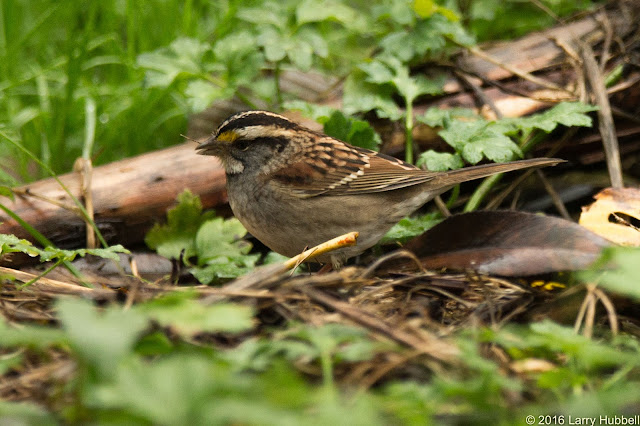Yesterday morning, Union Bay was filled with sunshine. The common mergansers seemed to enjoy it almost as much as I did.
There was bathing and wing-flapping by the male...
...and the female mergansers. Not only are the heads and backs of the females different colors than the males, the females apparently get their hair done at a stylish salon instead of the buzz-cut barber shop which the males frequent.
Although the males do have their moments. When a male sits in the sunshine and curves his neck into an elegant 'S' shape, I must admit he cuts a fairly fine looking figure.
Oddly, not all of the merganser's white or whitish feathers have this pink or salmon coloring.
It made me wonder if the wing feathers grew when the merganser was not eating the color-enhancing food or if their bodies simply produce both white and salmon colored feathers at the same time.
In spite of the color differences between the genders, their shapes are almost identical, especially when the females lay down their stylish head feathers. In our Master Birder Class we were taught that ignoring a bird's colors and focusing on their shape can sometimes actually make identification easier.
In addition to color differences on the head and back, the female common mergansers also seem to have less of the salmon coloring. Their undersides are much more white. I doubt that this has to do with dietary differences because the males and females are usually close together and they appear to be feeding on the same schools of fish.
In this photo, the foremost female does show a hint of a salmon tinge but it is clearly less extensive than in the males. In case you were wondering, my answer is no, I do not think the females eat less salmon. Plus, nothing I have read links the color of salmon meat to the salmon colored feathers on the mergansers, but it did make me wonder.
I ended up reading somewhere that a blue-green algae can induce flamingos to have a richer pink color. If that is true, then I suspect that the color of the food which the mergansers eat does not directly correlate with the coloring in their feathers. In fact, I suppose the differences in the head feathers of the male and female mergansers may actually prove that point. I wonder how the genetics in their bodies, and ours too, allow us to eat the same foods and yet produce different colored feathers, hair or skin.
In the case of the mergansers their gender genetics and body color genes must be very closely associated. Obviously, it is not the same with humans, but it does make me wonder would our society be better or worse if our color differences were gender based. My conclusion is that it is not how we look, but rather how we think and act which will determine whether our society improves or not.
Regardless of how the process works, there is no doubt that the mergansers love fish. Whenever a bird surfaces with food, its colleagues watch very closely. If the fish is large or awkwardly held, the others begin to close in. They obviously hope the fish will be dropped and they can pickup a free meal. Usually, within a second or two the first bird tips its head up and the fish disappears.
Whenever one merganser dives...
...the others quickly follow suit. It seems a bit like the old saying, 'Monkey see, Monkey do'. It may actually be very logical, if one bird spots a fish there may be more passing by. Plus, with multiple mergansers underwater they can surround a school of fish and cut off their escape routes.
I suspect as soon as their heads dip below the surface they are focused on food.
Their webbed feet give the initial dive a powerful boost and also propel them underwater.
It is easy to imagine how human divers came up with the idea for flippers.
One moment there can be a dozen mergansers floating offshore and seconds later there are only ripples fading across the surface.
I often think of the pattern of a bird's colors as being perfectly symmetrical. A closer look shows subtle differences, just like a human face. I wonder if these patterns help them to recognize their mates during breeding season.
*****************
By the way, common mergansers are cavity nesters. Since they cannot create their own holes in trees they must search for those created by others. They are one of the dozens of creatures who depend primarily on pileated woodpeckers for dry, spacious nesting sites. In turn woodpeckers depend on us to leave dead, standing nature trees which they can easily excavate to find food and create the cavities which they ultimately leave behind for others.
A squirrel taking shelter in an abandoned flicker nest in a dead cottonwood on Foster Island.
The preferred trees for woodpeckers, at least around Union Bay, are alder, cottonwood and willow. From a human perspective these are softwood trees which are not highly valued. However, every one of these dead trees which we leave standing - especially near water - makes life around Union Bay richer by increasing the reproduction of birds and other wildlife.
*****************
The larger splash on the left may indicate that the merganser is making a steering adjustment to chase after a fish.
If we had the time, equipment and inclination we could analyze the diving splashes of mergansers. I suspect the angle and size of the splash may indicate the direction and speed of the diving bird.
All of these photos were taken at the east end of Montlake Cut.
I counted more the two dozen mergansers in the area. It seems to me that they settle in around the entrance to Union Bay every winter. I suspect that Montlake Cut provides a bottle neck which increases the density of fish and makes their feeding more efficient.
Since I cannot supply you with flamingo photos from Union Bay, I will end this Thanksgiving weekend post with a final pinkish merganser photo.
I hope you had a Happy Thanksgiving!
Larry




































































